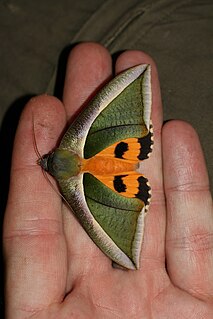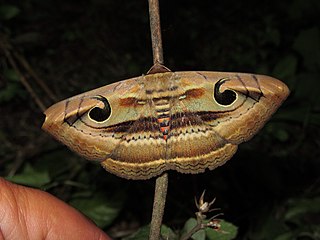
The Luna moth also known as the American moon moth is a Nearctic moth in the family Saturniidae, subfamily Saturniinae, a group commonly known as giant silk moths. It has lime-green colored wings and a white body. The larvae (caterpillars) are also green. Typically, it has a wingspan of roughly 114 mm (4.5 in), but can exceed 178 mm (7.0 in), making it one of the larger moths in North America. Across Canada, it has one generation per year, with the winged adults appearing in late May or early June, whereas farther south it will have two or even three generations per year, the first appearance as early as March in southern parts of the United States.

Hippotion velox, the dark striated hawkmoth, is a species of sphingid moth or the family Sphingidae. The species was described by Johan Christian Fabricius in 1793.

Mythimna decisissima is a moth of the family Noctuidae first described by Francis Walker in 1856. It is found from India across south-east Asia including Hong Kong, Japan, Taiwan and Australia in Queensland and New South Wales. It is also present in South Africa.

Spirama helicina is a moth of the family Erebidae first described by Jacob Hübner in 1824. In older texts, the species was classified as morph of Spirama retorta.

Eudocima salaminia, the green fruit-piercing moth, is a moth of the family Erebidae. The species was first described by Pieter Cramer in 1777. It is found from India, and across south-east Asia to the Pacific Islands. In Australia it occurs in the Northern Territory, Queensland and New South Wales. The adult is a fruit piercer.

Eucyclodes gavissima, the Oriental orange banded green geometer moth, is a species of moth of the family Geometridae described by Francis Walker in 1861. It is found in the Indian subregion, Sri Lanka, Bhutan, western China, Taiwan, Vietnam, Sumatra and Borneo.

Semiothisa eleonora is a moth of the family Geometridae. It is found in south-west Asia, including India, Sri Lanka and Taiwan.

Pinara metaphaea, the pinara moth, is a species of moth of the family Lasiocampidae. It was first described by Francis Walker in 1862. It is known from south-east Australia, including New South Wales and Victoria.

Ecliptopera muscicolor is a moth of the family Geometridae. It was described by Frederic Moore in 1888. It is found in India, Sri Lanka and Taiwan.

Fascellina chromataria is a moth in the family Geometridae described by Francis Walker in 1860. It is found in Korea, Japan, Taiwan, China, India, Bhutan and Sri Lanka.

Phazaca leucocera is a species of moth of the family Uraniidae. It is found in Sri Lanka, southern India, China, Borneo and the Solomon Islands.
Nannoarctia tripartita is a moth of the family Erebidae first described by Francis Walker in 1855. It is found in Myanmar, Thailand, Laos and Yunnan, China.

Spirama retorta, the Indian owlet-moth, is a moth of the family Erebidae. The species was first described by Carl Alexander Clerck in 1764. It is found in China, Korea, Japan (Honshu), India, Nepal, Bangladesh, Thailand, Cambodia, Myanmar, Vietnam, Taiwan, Sri Lanka, Malaysia, the Philippines (Luzon), Indonesia ,Japan.

Hyperythra lutea is a moth in the family Geometridae. The species was first described by Caspar Stoll in 1781. It is found in Indian subregion, Sri Lanka, South East Asia, Sundaland.
Virbia marginata is a moth in the family Erebidae. It was described by Herbert Druce in 1885. It is found in Mexico, Guatemala, Honduras, New Mexico and Arizona.

Virbia ostenta, the showy holomelina, is a moth in the family Erebidae. It was described by Henry Edwards in 1881. It is found in the mountain ranges of New Mexico, Arizona and Mexico.
Ancylolomia locupletellus, the Glossy grass-moth is a moth in the family Crambidae. It was described by Vincenz Kollar and Ludwig Redtenbacher in 1844. It is found in India.
Calamotropha atkinsoni is a moth in the family Crambidae. It was described by Philipp Christoph Zeller in 1863. It is found in south-east Asia, where it has been recorded from India, Sri Lanka, Thailand, Singapore and Sulawesi.
Donacaula dodatellus is a moth in the family Crambidae. It was described by Francis Walker in 1864. It is found in China (Yunnan), Japan, India, Myanmar, Sri Lanka, the Philippines and on Sumatra.
Rupela tinctella is a moth in the family Crambidae. It was described by Francis Walker in 1863. It is found in Florida, Georgia, Louisiana, Mississippi, North Carolina, South Carolina, Texas, Mexico, Cuba, the Guianas, Trinidad, Brazil (Paraná), Paraguay and northern Argentina.













